
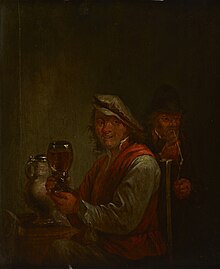
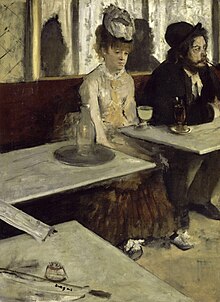
Recreational drug use is the use of one or more psychoactive drugs to induce an altered state of consciousness, either for pleasure or for some other casual purpose or pastime.[1] When a psychoactive drug enters the user's body, it induces an intoxicating effect.[1] Recreational drugs are commonly divided into three categories: depressants (drugs that induce a feeling of relaxation and calmness), stimulants (drugs that induce a sense of energy and alertness), and hallucinogens (drugs that induce perceptual distortions such as hallucination).[2]
In popular practice, recreational drug use is generally tolerated as a social behaviour,[1] rather than perceived as the medical condition of self-medication.[3] However, drug use and drug addiction are severely stigmatized everywhere in the world.[4][5][6] Many people also use prescribed and controlled depressants such as opioids, opiates, and benzodiazepines.[2] What controlled substances are considered generally unlawful to possess varies by country, but usually includes cannabis, cocaine, opioids, MDMA, amphetamine, methamphetamine, psychedelics, benzodiazepines, and barbiturates. As of 2015,[update] it is estimated that about 5% of people worldwide aged 15 to 65 (158 million to 351 million) had used controlled drugs at least once.[7]
Common recreational drugs include caffeine, commonly found in coffee, tea, soft drinks, and chocolate; alcohol, commonly found in beer, wine, cocktails, and distilled spirits; nicotine, commonly found in tobacco, tobacco-based products, and electronic cigarettes; cannabis and hashish (with legality of possession varying inter/intra-nationally); and the controlled substances listed as controlled drugs in the Single Convention on Narcotic Drugs (1961) and the Convention on Psychotropic Substances (1971) of the United Nations (UN).[8] Since the early 2000s, the European Union (EU) has developed several comprehensive and multidisciplinary strategies as part of its drug policy in order to prevent the diffusion of recreational drug use and abuse among the European population and raise public awareness on the adverse effects of drugs among all member states of the European Union, as well as conjoined efforts with European law enforcement agencies, such as Europol and EMCDDA, in order to counter organized crime and illegal drug trade in Europe.[8][9][10]
|
Main articles: Entheogenic use of cannabis, Epigenetics of cocaine addiction, and Molecular and epigenetic mechanisms of alcoholism |
|
Further information: Alcohol and Native Americans, History of drinking, History of opium in China, and History of smoking |


Many researchers have explored the etiology of recreational drug use.[1] Some of the most common theories are: genetics,[12] personality type, psychological problems, self-medication, sex, age, depression, curiosity, boredom, rebelliousness, a sense of belonging to a group, family and attachment issues, history of trauma, failure at school or work, socioeconomic stressors, peer pressure, juvenile delinquency, availability, historical factors, or socio-cultural influences.[13][14] There has been no consensus on a single cause.[13] Instead, experts tend to apply the biopsychosocial model.[13] Any number of factors may influence an individual's drug use, as they are not mutually exclusive.[13][14][15] Regardless of genetics, mental health, or traumatic experiences, social factors play a large role in the exposure to and availability of certain types of drugs and patterns of use.[13][14][16]
According to addiction researcher Martin A. Plant, some people go through a period of self-redefinition before initiating recreational drug use.[14] They tend to view using drugs as part of a general lifestyle that involves belonging to a subculture that they associate with heightened status and the challenging of social norms.[14] Plant states: "From the user's point of view there are many positive reasons to become part of the milieu of drug taking. The reasons for drug use appear to have as much to do with needs for friendship, pleasure and status as they do with unhappiness or poverty. Becoming a drug taker, to many people, is a positive affirmation rather than a negative experience".[14]
|
Main article: Evolutionary models of human drug use |
|
Further information: Effect of psychoactive drugs on animals and Recreational drug use in animals |
Anthropological research has suggested that humans "may have evolved to counter-exploit plant neurotoxins". The ability to use botanical chemicals to serve the function of endogenous neurotransmitters may have improved survival rates, conferring an evolutionary advantage. A typically restrictive prehistoric diet may have emphasized the apparent benefit of consuming psychoactive drugs, which had themselves evolved to imitate neurotransmitters.[17] Chemical–ecological adaptations and the genetics of hepatic enzymes, particularly cytochrome P450, have led researchers to propose that "humans have shared a co-evolutionary relationship with psychotropic plant substances that is millions of years old."[18]
|
Main articles: Addiction, Substance abuse, and Substance use disorder |

|
Further information: Addiction vulnerability, Alcohol intoxication, and Drug overdose |

The severity of impact and type of risks that come with recreational drug use vary widely with the drug in question and the amount being used. There are many factors in the environment and within the user that interact with each drug differently. Alcohol is sometimes considered one of the most dangerous recreational drugs. Alcoholic drinks, tobacco products and other nicotine-based products (e.g., electronic cigarettes), and cannabis are regarded by various medical professionals as the most common and widespread gateway drugs.[20][21][22][23] In the United States, Australia, and New Zealand, the general onset of drinking alcohol, tobacco smoking, cannabis smoking, and consumption of multiple drugs most frequently occurs during adolescence and in middle school and secondary school settings.[22][23][24][25][26]
Some scientific studies in the early 21st century found that a low to moderate level of alcohol consumption, particularly of red wine,[27] might have substantial health benefits such as decreased risk of cardiovascular diseases, stroke, and cognitive decline.[28][29][30] This claim has been disputed, specifically by British researcher David Nutt, professor of neuropsychopharmacology at the Imperial College London, who stated that studies showing benefits for "moderate" alcohol consumption in "some middle-aged men" lacked controls for the variable of what the subjects were drinking beforehand.[31] Experts in the United Kingdom have suggested that some psychoactive drugs that may be causing less harm to fewer users (although they are also used less frequently in the first place) are cannabis, psilocybin mushrooms, LSD, and MDMA; however, these drugs have risks and side effects of their own.[32]
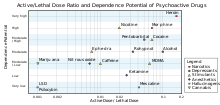

Drug harmfulness is defined as the degree to which a psychoactive drug has the potential to cause harm to the user and is measured in several ways, such as by addictiveness and the potential for physical harm. More objectively harmful drugs may be colloquially referred to as "hard drugs",[34] and less harmful drugs as "soft drugs".[35] The term "soft drug" is considered controversial by critics as it may imply the false belief that soft drugs cause lesser or insignificant harm.[35]
|
Main article: Responsible drug use |
Responsible drug use advocates that users should not take drugs at the same time as activities such as driving, swimming, operating machinery, or other activities that are unsafe without a sober state. Responsible drug use is emphasized as a primary prevention technique in harm-reduction drug policies. Harm-reduction policies were popularized in the late 1980s, although they began in the 1970s counter-culture, through cartoons explaining responsible drug use and the consequences of irresponsible drug use to users.[36] Another issue is that the illegality of drugs causes social and economic consequences for users—the drugs may be "cut" with adulterants and the purity varies wildly, making overdoses more likely—and legalization of drug production and distribution could reduce these and other dangers of illegal drug use.[37]
|
Main articles: Harm reduction, Preventive healthcare, Smoking ban, and Teetotalism |
|
Further information: Drug education, Native American temperance activists, Temperance movement, and Tobacco harm reduction |
In efforts to curtail recreational drug use, governments worldwide introduced several laws prohibiting the possession of almost all varieties of recreational drugs during the 20th century. The "War on Drugs" promoted by the United States, however, is now facing increasing criticism. Evidence is insufficient to tell if behavioral interventions help prevent recreational drug use in children.[38]
One in four adolescents has used an illegal drug, and one in ten of those adolescents who need addiction treatment get some type of care.[39] School-based programs are the most commonly used method for drug use education; however, the success rates of these intervention programs are highly dependent on the commitment of participants and are limited in general.[40]
|
Main articles: Drug education, Drug liberalization, Drug rehabilitation, and War on Drugs |
|
Further information: Illegal drug trade, Opioid epidemic, Prohibition of drugs, and Temperance movement |

|
Main article: Illicit drug use in Australia |
|
Further information: Alcoholism in rural Australia and Illegal drug trade in Australia |
Alcohol is the most widely used recreational drug in Australia.[43] 86.2% of Australians aged 12 years and over have consumed alcohol at least once in their lifetime, compared to 34.8% of Australians aged 12 years and over who have used cannabis at least once in their lifetime.[43]
|
Main articles: Federal drug policy of the United States, Illegal drug trade in the United States, and Prohibition in the United States |
|
Further information: Cocaine in the United States, Crack epidemic in the United States, Opioid epidemic in the United States, and Temperance movement in the United States |
From the mid-19th century to the 1930s, American physicians prescribed Cannabis sativa as a prescription drug for various medical conditions.[44] In the 1960s, the counterculture movement introduced the use of psychoactive drugs, including cannabis. Young adults and college students reported the recreational prevalence of cannabis, among other drugs, at 20-25% while the cultural mindset of using was open and curious.[45] In 1969, the FBI reported that between the years 1966 and 1968, the number of arrests for marijuana possession, which had been outlawed throughout the United States under Marijuana Tax Act of 1937, had increased by 98%.[46] Despite acknowledgement that drug use was greatly growing among America's youth during the late 1960s, surveys have suggested that only as much as 4% of the American population had ever smoked marijuana by 1969. By 1972, however, that number would increase to 12%. That number would then double by 1977.[47]
The Controlled Substances Act of 1970 classified marijuana along with heroin and LSD as a Schedule I drug, i.e., having the relatively highest abuse potential and no accepted medical use.[44][48] Most marijuana at that time came from Mexico, but in 1975 the Mexican government agreed to eradicate the crop by spraying it with the herbicide paraquat, raising fears of toxic side effects. Colombia then became the main supplier.[48] The "zero tolerance" climate of the Reagan and Bush administrations (1981–1993) resulted in passage of strict laws and mandatory sentences for possession of marijuana.[49] The "War on Drugs" thus brought with it a shift from reliance on imported supplies to domestic cultivation, particularly in Hawaii and California. Beginning in 1982, the Drug Enforcement Administration turned increased attention to marijuana farms in the United States, and there was a shift to the indoor growing of plants specially developed for small size and high yield. After over a decade of decreasing use, marijuana smoking began an upward trend once more in the early 1990s, especially among teenagers, but by the end of the decade this upswing had leveled off well below former peaks of use.[48]
|
Main articles: Drug culture, History and culture of substituted amphetamines, History of alcoholic drinks, and History of smoking |
|
Further information: Alcohol abuse among college students, Benzodiazepine drug misuse, Binge drinking, and Drug-facilitated sexual assault |

Many movements and organizations are advocating for or against the liberalization of the use of recreational drugs, most notably regarding the legalization of marijuana and cannabinoids for medical and/or recreational use.[44][50][51][52] Subcultures have emerged among users of recreational drugs,[53] as well as alternative lifestyles and social movements among those who abstain from them, such as teetotalism and "straight edge".[54]
Since the early 2000s, medical professionals have acknowledged and addressed the problem of the increasing consumption of alcoholic drinks and club drugs (such as MDMA, cocaine, rohypnol, GHB, ketamine, PCP, LSD, and methamphetamine) associated with rave culture among adolescents and young adults in the Western world.[55][56][57][58][59] Studies have shown that adolescents are more likely than young adults to use multiple drugs,[60] and the consumption of club drugs is highly associated with the presence of criminal behaviors and recent alcohol abuse or dependence.[61]
The prevalence of recreational drugs in human societies is widely reflected in fiction, entertainment, and the arts, subject to prevailing laws and social conventions. For instance, in the music industry, the musical genres hip hop, hardcore rap, and trap, alongside their derivative subgenres and subcultures, are most notorious for having continuously celebrated and promoted drug trafficking, gangster lifestyle, and consumption of alcohol and other drugs since their inception in the United States during the late 1980s–early 1990s.[62][63][64][65] In video games, for example, drugs are portrayed in a variety of ways: including power-ups (cocaine gum replenishes stamina in Red Dead Redemption 2), obstacles to be avoided (such as the Fuzzies in Super Mario World 2: Yoshi's Island that distort the player's view when accidentally consumed), items to be bought and sold for in-game currency (coke dealing is a big part of Scarface: The World Is Yours). In the Fallout video game franchise, drugs ("chems" in the game) can fill the role of any above mentioned.[66] Drug trafficking, gang rivalries, and their related criminal underworld also play a big part in the Grand Theft Auto video game franchise.[66]
The following substances are commonly used recreationally:[67]
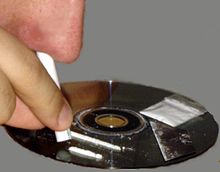
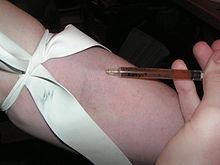
Drugs are often associated with a particular route of administration. Many drugs can be consumed in more than one way. For example, marijuana can be swallowed like food or smoked, and cocaine can be "sniffed" in the nostrils, injected, or, with various modifications, smoked.
Many drugs are taken through various routes. Intravenous route is the most efficient, but also one of the most dangerous. Nasal, rectal, inhalation and smoking are safer. The oral route is one of the safest and most comfortable, but of little bioavailability.
|
Further information: Depressant |
Depressants are psychoactive drugs that temporarily diminish the function or activity of a specific part of the body or mind.[92] Colloquially, depressants are known as "downers", and users generally take them to feel more relaxed and less tense. Examples of these kinds of effects may include anxiolysis, sedation, and hypotension. Depressants are widely used throughout the world as prescription medicines and as illicit substances. When these are used, effects may include anxiolysis (reduction of anxiety), analgesia (pain relief), sedation, somnolence, cognitive/memory impairment, dissociation, muscle relaxation, lowered blood pressure/heart rate, respiratory depression, anesthesia, and anticonvulsant effects. Depressants exert their effects through a number of different pharmacological mechanisms, the most prominent of which include potentiation of GABA or opioid activity, and inhibition of adrenergic, histamine or acetylcholine activity. Some are also capable of inducing feelings of euphoria. The most widely used depressant by far is alcohol (i.e. ethanol).
Stimulants or "uppers", such as amphetamines or cocaine, which increase mental or physical function, have an opposite effect to depressants.
Depressants, in particular alcohol, can precipitate psychosis. A 2019 systematic review and meta-analysis by Murrie et al. found that the rate of transition from opioid, alcohol and sedative induced psychosis to schizophrenia was 12%, 10% and 9% respectively.[93]
|
Further information: Antihistamine |
Antihistamines (or "histamine antagonists") inhibit the release or action of histamine. "Antihistamine" can be used to describe any histamine antagonist, but the term is usually reserved for the classical antihistamines that act upon the H1 histamine receptor. Antihistamines are used as treatment for allergies. Allergies are caused by an excessive response of the body to allergens, such as the pollen released by grasses and trees. An allergic reaction causes release of histamine by the body. Other uses of antihistamines are to help with normal symptoms of insect stings even if there is no allergic reaction. Their recreational appeal exists mainly due to their anticholinergic properties, that induce anxiolysis and, in some cases such as diphenhydramine, chlorpheniramine, and orphenadrine, a characteristic euphoria at moderate doses.[citation needed] High dosages taken to induce recreational drug effects may lead to overdoses. Antihistamines are also consumed in combination with alcohol, particularly by youth who find it hard to obtain alcohol. The combination of the two drugs can cause intoxication with lower alcohol doses.
Hallucinations and possibly delirium resembling the effects of Datura stramonium can result if the drug is taken in much higher than therapeutic doses. Antihistamines are widely available over the counter at drug stores (without a prescription), in the form of allergy medication and some cough medicines. They are sometimes used in combination with other substances such as alcohol. The most common unsupervised use of antihistamines in terms of volume and percentage of the total is perhaps in parallel to the medicinal use of some antihistamines to extend and intensify the effects of opioids and depressants. The most commonly used are hydroxyzine, mainly to extend a supply of other drugs, as in medical use, and the above-mentioned ethanolamine and alkylamine-class first-generation antihistamines, which are – once again as in the 1950s – the subject of medical research into their anti-depressant properties.
For all of the above reasons, the use of medicinal scopolamine for recreational uses is also observed.
|
Further information: Analgesic |
Analgesics (also known as "painkillers") are used to relieve pain (achieve analgesia). The word analgesic derives from Greek "αν-" (an-, "without") and "άλγος" (álgos, "pain"). Analgesic drugs act in various ways on the peripheral and central nervous systems; they include paracetamol (also known in the US as acetaminophen), the nonsteroidal anti-inflammatory drugs (NSAIDs) such as the salicylates (e.g. aspirin), and opioid drugs such as hydrocodone, codeine, heroin and oxycodone. Some further examples of the brand name prescription opiates and opioid analgesics that may be used recreationally include Vicodin, Lortab, Norco (hydrocodone), Avinza, Kapanol (morphine), Opana, Paramorphan (oxymorphone), Dilaudid, Palladone (hydromorphone), and OxyContin (oxycodone).
|
Further information: Tranquilizer |
The following are examples of tranquilizers (GABAergics):
|
Further information: Stimulant |
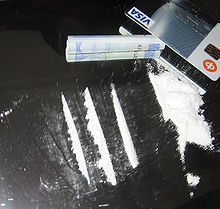
Stimulants, also known as "psychostimulants",[94] induce euphoria with improvements in mental and physical function, such as enhanced alertness, wakefulness, and locomotion. Stimulants are also occasionally called "uppers". Depressants or "downers", which decrease mental or physical function, are in stark contrast to stimulants and are considered to be their functional opposites.
Stimulants enhance the activity of the central and peripheral nervous systems. Common effects may include increased alertness, awareness, wakefulness, endurance, productivity, and motivation, arousal, locomotion, heart rate, and blood pressure, and a diminished desire for food and sleep.
Use of stimulants may cause the body to significantly reduce its production of endogenous compounds that fulfill similar functions. Once the effect of the ingested stimulant has worn off the user may feel depressed, lethargic, confused, and dysphoric. This is colloquially termed a "crash" and may promote reuse of the stimulant.
Amphetamines are a significant cause of drug-induced psychosis. Importantly, a 2019 meta-analysis found that 22% of people with amphetamine-induced psychosis transition to a later diagnosis of schizophrenia.[93]
Examples of stimulants include:
|
Further information: Euphoriant |
|
Further information: Hallucinogen |
|
See also: List of psychedelic drugs |
Hallucinogens can be divided into three broad categories: psychedelics, dissociatives, and deliriants. They can cause subjective changes in perception, thought, emotion and consciousness. Unlike other psychoactive drugs such as stimulants and opioids, hallucinogens do not merely amplify familiar states of mind but also induce experiences that differ from those of ordinary consciousness, often compared to non-ordinary forms of consciousness such as trance, meditation, conversion experiences, and dreams.
Psychedelics, dissociatives, and deliriants have a long worldwide history of use within medicinal and religious traditions. They are used in shamanic forms of ritual healing and divination, in initiation rites, and in the religious rituals of syncretistic movements such as União do Vegetal, Santo Daime, Temple of the True Inner Light, and the Native American Church. When used in religious practice, psychedelic drugs, as well as other substances like tobacco, are referred to as entheogens.
Hallucinogen-induced psychosis occurs when psychosis persists despite no longer being intoxicated with the drug. It is estimated that 26% of people with hallucinogen-induced psychosis will transition to a diagnosis of schizophrenia. This percentage is less than the psychosis transition rate for cannabis (34%) but higher than that of amphetamines (22%).[93]
Starting in the mid-20th century, psychedelic drugs have been the object of extensive attention in the Western world. They have been and are being explored as potential therapeutic agents in treating depression, post-traumatic stress disorder, obsessive–compulsive disorder, alcoholism, and opioid addiction. Yet the most popular, and at the same time most stigmatized, use of psychedelics in Western culture has been associated with the search for direct religious experience, enhanced creativity, personal development, and "mind expansion". The use of psychedelic drugs was a major element of the 1960s counterculture, where it became associated with various social movements and a general atmosphere of rebellion and strife between generations.
|
Further information: Inhalant |
Inhalants are gases, aerosols, or solvents that are breathed in and absorbed through the lungs. While some "inhalant" drugs are used for medical purposes, as in the case of nitrous oxide, a dental anesthetic, inhalants are used as recreational drugs for their intoxicating effect.[101] Most inhalant drugs that are used non-medically are ingredients in household or industrial chemical products that are not intended to be concentrated and inhaled, including organic solvents (found in cleaning products, fast-drying glues, and nail polish removers), fuels (gasoline (petrol) and kerosene), and propellant gases such as Freon and compressed hydrofluorocarbons that are used in aerosol cans such as hairspray, whipped cream, and non-stick cooking spray. A small number of recreational inhalant drugs are pharmaceutical products that are used illicitly, such as anesthetics (ether and nitrous oxide)[101] and volatile anti-angina drugs (alkyl nitrites, more commonly known as "poppers").
The most serious inhalant abuse occurs among children and teens who "[...] live on the streets completely without family ties".[102] Inhalant users inhale vapor or aerosol propellant gases using plastic bags held over the mouth or by breathing from a solvent-soaked rag or an open container. The effects of inhalants range from an alcohol-like intoxication and intense euphoria to vivid hallucinations, depending on the substance and the dosage. Some inhalant users are injured due to the harmful effects of the solvents or gases, or due to other chemicals used in the products inhaled. As with any recreational drug, users can be injured due to dangerous behavior while they are intoxicated, such as driving under the influence. Computer cleaning dusters are dangerous to inhale, because the gases expand and cool rapidly upon being sprayed. In many cases, users have died from hypoxia (lack of oxygen), pneumonia, cardiac failure or arrest,[103] or aspiration of vomit.
Examples include:
|
See also: Smoking and List of plants used for smoking |
Plants:
Substances (also not necessarily psychoactive plants smoked within them):
|
See also: List of psychoactive plants |
Minimally psychoactive plants which contain mainly caffeine and theobromine:
Most known psychoactive plants:
Solanaceae plants—contain atropine, hyoscyamine, and scopolamine:
Other plants:
Fungi:
Psychoactive animals: